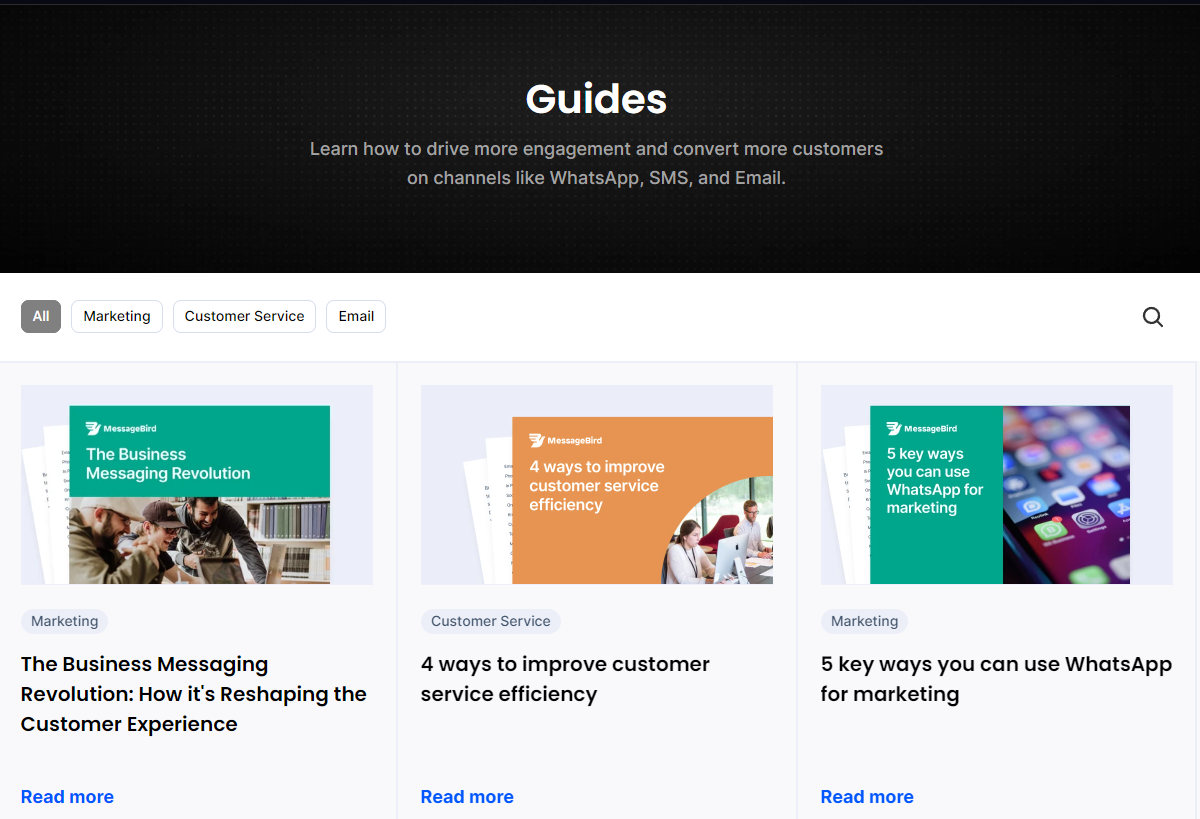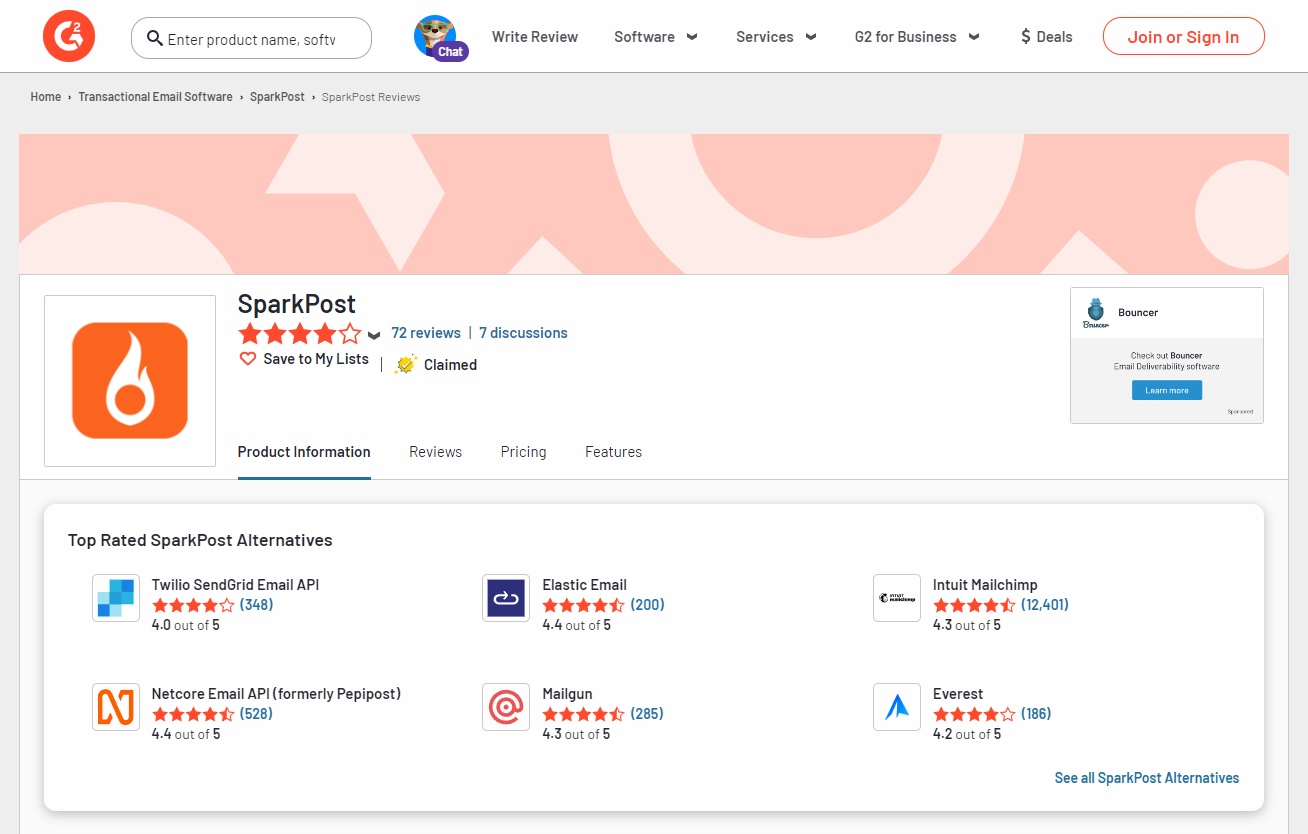With email marketing being an essential component of any successful customer engagement strategy, choosing the right email service provider (ESP) is a crucial decision for small business owners and marketers.
Sparkpost and SendGrid are two popular ESPs that provide solutions for sending high volumes of email easily. Selecting between these two formidable options can impact deliverability rates, integration capabilities, and ultimately, return on investment.
In this comprehensive Sparkpost vs SendGrid comparison guide, we will evaluate how the two platforms stack up across key criteria like features and functionality, ease of use, reliability, support, and pricing. With insights into the strengths and weaknesses of each email marketing platform, small business owners can better determine which solution will effectively meet their unique email marketing needs.
1. Understanding the Basics
SparkPost was founded in 2014 by the founders of SMTP provider Message Systems. The CEO is Rich Harris, who has a background in building email infrastructure companies. SparkPost has rapidly grown in popularity, now serving billions of emails per month to over 5,000 customers.
SendGrid was launched in 2009, founded by three former Force.com engineers: Tim Jenkins, Jose Lopez, and Isaac Saldana. Twilio acquired SendGrid in 2018 for $3 billion. SendGrid has established itself as one of the most widely-used ESPs, trusted by massive brands like Spotify, Airbnb, and Uber.
Both SparkPost and SendGrid have become leaders in the email service provider space. SparkPost touts strong momentum with a modern infrastructure, while the long-standing SendGrid offers exceptional scalability and deliverability.
2. Features and Functionality
Automation
SparkPost

SparkPost offers powerful email marketing automation capabilities through an intuitive drag-and-drop workflow builder. Users can create complex chains of triggered emails for welcome series, abandoned cart flows, subscriptions, and more.
SparkPost’s Automation feature lets you set up “if/then” rules to send the right messages to the right contacts at the right time. For example, you can send an abandoned cart reminder to customers who didn’t complete a purchase or customize life cycle campaigns based on subscriber engagement.
Advanced options like A/B testing, analytics integration, scheduling, and templates allow extensive customization for automation programs. The easy-to-use visual interface makes it simple for beginners to run marketing campaigns and enables developers to use coding customization.
SendGrid
The Automation 360 plan unlocks SendGrid’s workflow automation engine. Users can build multi-step workflows with triggers based on subscriber actions, schedules, event data from other apps, and more.
SendGrid focuses heavily on flexibility – contacts can enter automation workflows from any channel, and you can customize welcome messages, win-back series, browsing abandonment flows, and post-conversion nurturing.
While the workflow builder isn’t quite “drag-and-drop”, it uses an intuitive series of “if this, then that” logic to trigger automated emails for highly targeted segments. Custom coding and open API access provide advanced options.
Winner: SparkPost
With an edge in visual design and an intuitive builder for beginners, SparkPost takes the prize for the best email automation tools. The drag-and-drop workflow creation and advanced options strike an ideal balance of complexity versus usability.
Email Templates
SparkPost

SparkPost provides hundreds of professionally designed email templates that can be edited right within the app. Templates are organized by category, making it easy to find relevant options for promotional, re-engagement, or transactional messages.
SparkPost’s drag-and-drop email builder simplifies customizing templates based on your brand and message. Flexible text, images, colors, blocks, and style settings allow extensive changes while retaining responsive mobile visibility. Dynamic text and image merging ensures personalized, targeted messaging at scale.
The template builder also offers integration with your brand fonts, images, and CSS for a consistent look and feel. For coding experts, HTML templates can be written from scratch or imported and edited from external tools.
SendGrid
SendGrid’s email templates make it easy for users of any skill level to craft professional emails. Start from hundreds of pre-built templates or canvas layouts in the drag-and-drop editor, applying your colors, fonts, images, and branding efficiently.
Personalization is simple through substitution tags that pull in customer data dynamically to customize messages. Templates are immediately rendered for mobile devices so you can confirm a responsive design.
While less robust for design customization than SparkPost, you can use the code editor for fine tweaks. Integration with design tools like Webflow streamlines moving HTML email templates into SendGrid’s platform.
Winner: SparkPost
SparkPost takes template creation to the next level with extensive control over designs when customizing pre-built options. Plus, easier personalization, branding capabilities, and coding flexibility give SparkPost the win for the best email templates.
Segmentation
SparkPost

SparkPost enables highly targeted email campaigns through robust segmentation options. Senders can create unlimited segments based on detailed recipient behavior, profile data, engagement metrics, and more.
Segments can be dynamic – automatically updated based on real-time activity like email opens, clicks, transactions, and website actions. Combining filters with “and/or” logic makes complex targeting a breeze.
SparkPost lets you test segment criteria before finalizing lists. Handy Venn diagrams provide visual representation when combining multiple segments for multi-faceted targeting scenarios.
The platform makes it simple to organize all segments in one place for current snapshots of your most valuable groups for engagement. Overall, easy segment management powers personalized messaging at scale.
SendGrid
SendGrid focuses more on traditional static segmentation compared to SparkPost’s real-time dynamic options. You can still target customer groups based on profile data and attributes to drive personalized communications.
Basic filters, tags, and contact list creation provide the building blocks for segmented distribution. Automations enhance targeting through event-triggered emails – you could send a win-back message to dormant subscribers after 90 days of inactivity, for example.
While functional for general scenarios, SendGrid lags SparkPost when more complex, multi-variable targeting based on ongoing behaviors is needed to differentiate messaging. Lacking breadcrumb trails of engagement, segments feel static compared to SparkPost’s fluid, evolving contact groups.
Winner: SparkPost
With greater depth in dynamic segmentation catered to real-time user actions, SparkPost earns the win. Granular targeting and automated list updating allow you to send emails with the highest personalization and relevance for each phase of the customer lifecycle.
Analytics
SparkPost

SparkPost provides powerful email analytics both within campaigns and across your entire account. Real-time reporting offers insights into opens, clicks, bounces, blocks, and spam complaints. Maps showcase regional engagement levels.
Drill-downs analyze performance by device type, browser, mailbox provider, and more. Side-by-side campaign comparisons spot trends and differences. Engagement and read-time metrics show whether subscribers consumed content.
SparkPost’s advanced plan integrates directly with popular analytics platforms like MixPanel, Segment, and Heap for deeper analysis and closed-loop optimization based on wider business KPIs. Robust data for enhancing deliverability and fine-tuning audience targeting.
SendGrid
SendGrid focuses more on campaign-specific email analytics rather than account-wide real-time analytics data. Reports contain opens, clicks, bounces, unsubscribes, spam reports, and more. Heat and click maps visually indicate interactions.
Comparison charts help you gauge improvements in key metrics campaign over the campaign. Statistics can be broken down by location, device, browser, and other parameters to optimize segmentation.
For wider-scope analytics, SendGrid relies more on its integrations with business intelligence tools like Google Analytics, Salesforce, and Oracle instead of baked-in functionality. Decent campaign insights, but lacks holistic engagement tracking.
Winner: SparkPost
This SparkPost SendGrid comparison shows that with stronger account intelligence and real-time engagement metrics spanning channels, SparkPost claims the victory for best-in-class email analytics. SendGrid competes at the individual campaign level but lacks the unified scope or integration support across customer touchpoints.
Unique Features
SparkPost

SparkPost is a more modern email offering with robust email infrastructure and API capabilities. Built-in reCAPTCHA and anomaly detection protect against spam threats, while sender signatures and DMARC improve deliverability.
The platform specializes in transactional email through high performance and reliability. Sub-second send times at scale help send mission-critical communications like order confirmations or account updates promptly.
SparkPost’s unique Permissions Grid powers highly customized role access management across teams – from full admin permissions to limited send/view analytics only. Content and template review workflows for compliance.
SendGrid
SendGrid developed a clever Warm Up Sender tool to gradually introduce new sending infrastructure to ISPs without seeming suspicious, protecting the sender’s reputation.
Health & Delivery Insights provides deep domain, IP, and link analysis across communications to optimize deliverability The platform is well-suited for multi-channel strategies with its Courier mobile notifications and Email News Feed Reader options.
SendGrid offers priority enterprise support via phone and chat for high-ticket consultation on designing complex email programs and troubleshooting obstacles.
Winner: SparkPost
With specialization in infrastructure, compliance, and transactional use cases beyond basic email, SparkPost edges out SendGrid for its most unique capabilities. Its architectural strengths lend better to scaling high-volume communications.
3. Ease of Use
SparkPost

SparkPost provides an intuitive, modern interface for managing email campaigns. Setup is easy and the left nav menu offers clear access to core features like campaigns, templates, reports, and recipient lists. Drag-and-drop modules streamline building emails.
Wizards guide beginners through creating first campaigns while letting more advanced users skip ahead. Contextual help menus and hovering tooltips explain settings to accelerate onboarding. Segmentation and automation builders use visual editors suited for new email marketers.
The flow-based visual workflow builder lends well to designing complex triggers, filters, and multi-step scenarios with “if/then” logic. Overall, SparkPost strikes a nice balance of complexity to serve experienced users while remaining accessible for novices.
SendGrid
SendGrid opts for simplicity in its interface design and workflow builders, which improves usability for first-time email senders. Getting started feels approachable with basic options, and then power users can access more granular controls in settings menus.
The streamlined menu condensed core modules for sending, managing contacts, building campaigns, and analyzing reports. Wizards auto-populate settings for quicker configuration. Easy-to-follow tutorials demonstrate platform functionality for new users.
While the UI simplifies options for beginners, it eventually feels limiting for advanced job queues, automation scenarios, and custom coding needs. SendGrid trades depth for accessibility.
Winner: Tie
SparkPost offers greater capabilities for experienced users while SendGrid promotes easier onboarding for beginners. For overall ease of use, both platforms effectively serve their target users through thoughtful interfaces and UX design tailored to each level. We declare this category a tie.
4. Email Deliverability
SparkPost

SparkPost prioritizes deliverability through built-in protections like spam filtering, threat detection, and domain authentication. The platform uses contextual messaging and predictive email intelligence to maximize inbox placement.
Granular traffic shaping options allow controlling the volume and speed of emails to avoid triggering spam filters. Real-time visibility into bounced and rejected messages helps tweak content, segmentation, or sender profiles to improve future delivery.
SparkPost also provides deliverability consulting services and Managed Deliverability options where their team handles setting up, troubleshooting, and optimizing at scale.
SendGrid
With over 8 million customers trusting SendGrid has deliverability rates comparable to the best ESPs in the industry. For reliable inbox delivery, their maturity shines through in optimized sender reputations, IP warming, and strong relationships with major ISPs to facilitate deliverability and avoid the spam folder.
SendGrid Lock delivers a dedicated pool of IP addresses to each customer for independent reputation building and protects domains from sharing tainted IPs. Two-way TLS encryption between endpoints prevents tampering with valuable transactional emails.
Robust tracking provides visibility into email bottlenecks while their new Intelligent Framework offers customized routing plans using AI to optimize pathways.
Winner: Tie
Both SparkPost and SendGrid are scalable email delivery solutions that offer fantastic deliverability, security, and inbox placement capabilities. Their years of experience and continual improvements make either solution a fantastic choice for any business to raise their email visibility and protect send reputation. We declare deliverability standards a tie between these leading ESPs.
5. Customer Support and Community
SparkPost

SparkPost offers multiple support channels including live chat, email tickets, community forums for advice from other users, and an in-depth knowledge base of help articles and troubleshooting guides.
Every plan comes with standard support via chat and email, with quick initial responses. Higher-tier plans provide priority routing and dedicated Technical Account Managers for personalized high-touch consultations.
While community forums and self-serve resources prove useful for common issues, SparkPost’s full-service options excel for technical troubleshooting or strategic planning. Join the SparkPost Community Facebook Group to engage with over 5,000 fellow users.
SendGrid
SendGrid prioritizes 24/7 chat, phone, and email support with their Diamond plan, while lower tiers receive business-hour assistance. Response times range from 2 minutes for Diamond customers down to 24 hours for free users.
Alongside the expected suite of self-help options with knowledge base articles, documentation, and tutorial videos guiding platform and deliverability troubleshooting. SendGrid maintains an active online community in their public Community and Facebook Group.
SendGrid’s premium Diamond phone support stands above SparkPost, but most users opt for more affordable packages with decent email-based assistance and lively peer forums.
Winner: SparkPost
Featuring tailored support plans catering from beginners to experts across several channels, SparkPost edges out SendgGrid as the category winner here. Quicker responses and dedicated managers provide better value for the majority of small business owners.
6. Integrations
SparkPost

SparkPost enables connecting your email campaigns to a wider marketing and operations stack through open API integration and partnerships turnkey connectors. You can easily integrate the platform’s robust API with your workflows
Over 500+ public APIs handle list syncing, data enrichment, metric tracking, behavioral event triggers, and more. CRM tools like Salesforce integrate out-of-the-box, while developers can leverage code libraries for custom applications.
Partnerships power easy integration without IT resources. SparkPost boasts native plugins for leading e-commerce platforms like Shopify and Magento for real-time order updates and customer engagement options.
SendGrid
SendGrid takes an API-first approach, with 7 core APIs enabling developers to integrate email capabilities into custom apps and back-end systems for complete visibility and functionality.
The API platform ecosystem consists of thousands of registered apps and integrators across CRMs, social media, analytics, and popular frameworks spanning use cases from marketing automation to platform management.
For less technical users, SendGrid’s App Marketplace contains one-click installable turnkey applications like Mailchimp, HubSpot, and Eventbrite to expand functionality with minimal lift.
Winner: Tie
Both options enable extensibility through developer APIs for custom systems alongside turnkey integrations with major marketing and business systems. For breadth and depth of connectivity, SparkPost and SendGrid deliver flexibility and remain evenly matched.
7. Pricing
SparkPost

SparkPost offers a free plan for testing or low monthly email volume including basic analytics, 200 monthly emails, and 2 templates.
The Standard paid plan runs $20/month including more emails, segmentation, and automation features. Pro plans add priority support, more emails, and compliance tools starting at $395. Enterprise custom quotes offer dedicated IPs, volumes over 150K/month, and custom SLAs.
Overall, SparkPost delivers excellent bang for your buck across all tiers. Entry-level plans provide strong deliverability and features to power most small businesses’ needs affordably.
SendGrid
SendGrid’s free tier allows 100 emails/day including analytics and assistive deliverability tools. The Essentials plan price is $15 for up to 40,000 emails and you pay more based on how many emails you want to send, as well as contacts and basic automation.
You can upgrade to higher volume premier plan options which scale up with more emails, segments, and dedicated IPs. Upgrading to Marketing Campaign packages adds a bit more automation and customized sender identities. The premium Support+ package caters to huge volumes with dedicated infrastructure.
For large enterprises managing tens of millions of emails, SendGrid offers highly customized quotes and support SLAs more suited for huge scale than SparkPost’s options.
Winner: SparkPost
SparkPost pulls ahead on pricing for small to medium businesses, with very generous free inclusions and affordable growth to fit more moderate email volumes. SendGrid only edges ahead at extremely high-tier use cases above SparkPost’s intended customer size.
8. Reviews and Reputation
SparkPost

SparkPost earns strong reviews across software review sites like G2 and Capterra, highlighted by its 4.4/5 stars on G2 from over 140 verified user reviews.
Praise focuses on excellent deliverability, dedicated IP, easy-to-use and intuitive interface, quality support, and overall value for money. Some negatives of the cloud-based SMTP service point out the occasional glitches with automated messages, template limitations, and a learning curve for advanced configuration.
Considering its modern infrastructure and more attractive pricing, reviews reflect SparkPost as a top challenger for popular consumer mail clients, which is why the company is quickly gaining a reputation in the ESP industry.
SendGrid
With over 6,300 reviews averaged to a 4.5/5 star overall rating, SendGrid enjoys tremendous validation across major software review platforms like G2 Crowd, Capterra, and TrustRadius.
The platform earns consistent praise for reliable delivery and scalability thanks to strong partnerships with major ISPs. Reviews also mentioned world-class deliverability consultancy and customer support options.
Despite being the priciest option, the vast majority agree that SendGrid provides fantastic reliability and inbox placement at huge volumes to warrant the costs for established enterprises.
Winner: SendGrid
Boasting nearly 10x more validated reviews averaging slightly higher satisfaction, SendGrid emerges as the winner for strongest industry validation. SparkPost makes fantastic inroads but currently lacks the reputation scale and longevity of SendGrid.
9. FAQ’s
SparkPost FAQs
- What kind of support does SparkPost offer?
SparkPost provides email, chat, community forums, and phone support options depending on your account tier. All paid plans include email tickets. Higher tiers add priority routing and dedicated account managers. - Does SparkPost have email templates?
Yes, SparkPost offers hundreds of customizable templates spanning categories like promotional, transactional, and behavioral emails. Templates can be edited directly with a drag-and-drop builder. - How does SparkPost handle deliverability?
SparkPost optimizes deliverability through automatic spam filtering, threat analysis, sender signing, traffic shaping, and other protections. They provide visibility into failures and have deliverability consultants available. - Does SparkPost integrate with CRMs and marketing automation platforms?
Yes, SparkPost offers open API integration as well as turnkey connectors for leading systems like Salesforce, Marketo, and Hubspot. Over 500+ APIs available. - Is there a free trial?
SparkPost offers a free tier allowing 12,000 emails for up to 3 months to test the platform. Paid packages start at $20/month.
Twilio SendGrid FAQs
- What kind of deliverability does SendGrid offer?
SendGrid has a strong sender reputation and partnerships with major ISPs to facilitate 97%+ global delivery rates. Features like link tracking, reputation monitoring, and analytics identify potential improvement areas. - Does SendGrid have email templates?
Yes, SendGrid offers hundreds of ready-made, customizable templates. An intuitive drag-and-drop editor makes template building easy. - How does SendGrid handle automation?
The Automation 360 plan unlocks multi-step workflow functionality leveraging triggers based on schedules, user behaviors, app events, and complex logic. - What support options are included?
SendGrid offers 24/7 live chat and phone support on premium plans. Lower tiers receive business hour email and chat assistance. All users can access community forums and an extensive knowledge base. - Is there a free trial?
Yes, SendGrid has a free 30-day trial for the Marketing Campaign package, normally $15/month thereafter.
Final Thoughts
Choose SparkPost if…
With strengths in infrastructure adaptability, segmentation precision, high deliverability, and automation workflows that let you build custom applications for your business, SparkPost excels as part of a growth-stage marketing stack where flexibility and technical capabilities take priority over ease of use.
SparkPost best suits mid-market companies planning to scale complexity in the future that need a solution meeting developers and marketers in the middle with balanced power and usability.
Choose SendGrid if…
SendGrid remains the gold standard for enterprise-level email delivery thanks to superior deliverability track records built with major ISPs over the years.
Larger established companies who prioritize extreme reliability at huge monthly volumes will thrive with SendGrid’s expertise while smaller firms can start affordably and scale up their email program. If inbox placement is critical for your transactional or engagement campaigns, SendGrid is a prudent choice.
Making the right email service provider choice is critical for executing effective engagement strategies and ensuring your hard work reaches the inbox. We hope this comparison provides clarity to inform your decision between these two industry leaders. Please ask any outstanding questions in the comments and we’re happy to provide personalized guidance!
